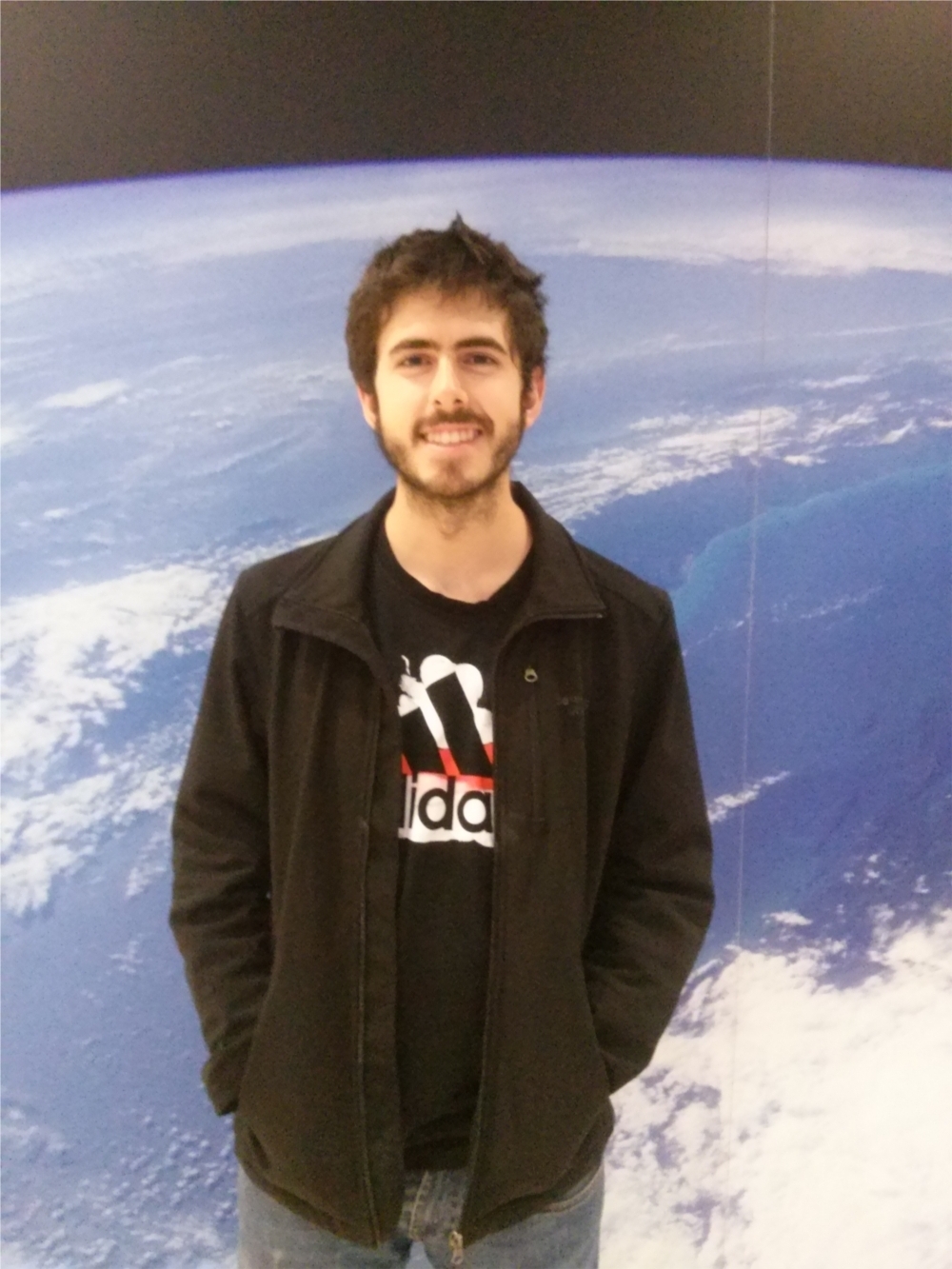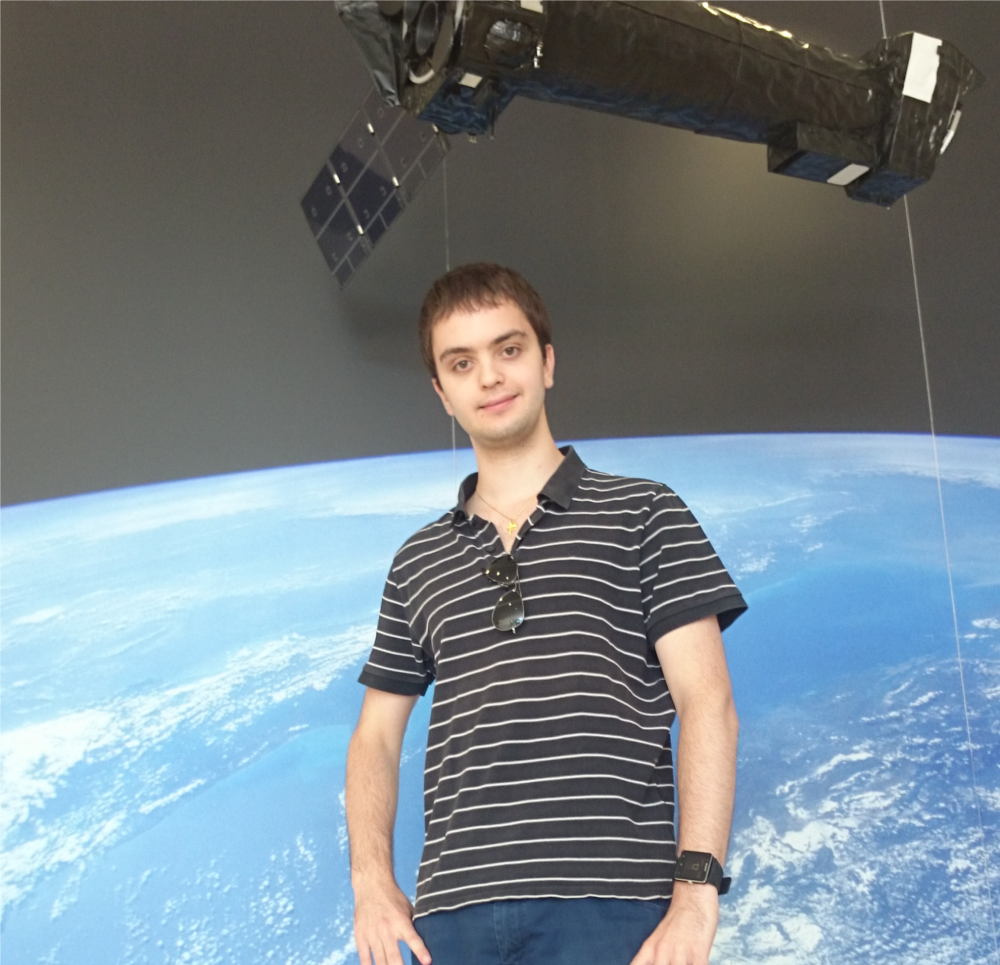Trainees 2014 - ESAC Trainees
 |
2014 Trainees
|
Re-entry modelling validation and testing to save the Earth and protect humankind
Tutors. Emmet Fletcher, Irene Huertas, Luis Martin, Guillermo Ortega, Mihai Ghita & Vicente Navarro Satellite Surveillance and Tracking (SST) is part of the Space Situational Awareness Program of ESA. One great challenge of SST is predicting the decay and atmospheric re-entry of space objects (satellites, rocket stages, debris). This is done with RPS (Re-entry Prediction System), a software product written in Fortran, C++ and Java, that computes lifetimes, classifies database objects according to their risk, and predicts trajectories and footprints of objects until they burn or impact the ground. This is important in order to minimize the risk posed to human activities on ground. Some of the problems that the RPS has to deal with are analytical determination of lifetimes, boundary value problems for determining ballistic coefficients, numerical integration of orbital differential equations with perturbations, statistical on ground distributions of disintegrating object and risk assessment. Defining and running test cases to cover the most important problems was one of the tasks that I accepted. As we found out, the RPS can be greatly improved, computing time can be minimized, uncertainties can be reduced, and the robustness of the system can be increased.
|
 |
Mihai Pripasu Institute of Space Science, Magurele-Ilfov, Romania |
|
Alberto Perez Gonzalez-Haba
Universidad Politécnica de Madrid
|
 |
Web-based SPICE Data Distribution System
Tutors. Dave Heather & jose Luis Vazquez During my traineeship I developed an interface to organize ephemeris information (contained in files named Kernels, in SPICE code). Besides organizing Kernels and displaying their most relevant information, the portal interface can also assist potential new users on choosing the right ephemeris data files required for their needs. The interface integrates C++, PostgreSQL and PHP.
|
|
X-ray binaries as strong gravity laboratories: hunting for the signature of Gerneral Relativity in neutron star accreting binaries
Tutors. Sara Motta & Erik Kuulkers The theory of General Relativity predicts that the characteristic frequencies of the motion of matter in the close vicinity of a black hole or a neutron star can be detected in the X-ray emission from an accreting black hole or neutron star binary in the form of quasi periodic oscillations (QPOs, i.e. peaks in the power spectra of the signal from the source) and can provide key information on the space-time properties in the strong-field regime. With the currently available data from RXTE we are now able to look for traces of General relativity in the X-ray emission of accreting neutron star binaries and to test the most promising theoretical models for QPOs in accreting systems. We undertake a systematic search for QPOs in the X-ray data of a complete sample of neutron star accreting binaries in order to classify them on the basis of special "spectral states" usually observed in accreting systems. This classification completes the observational picture of accreting NS X-ray binaries and allows us to directly compare these systems to the similar, yet different BH X-ray binaries, in order to establish similarities and differences in the fast-time variability properties in these two kind of objects.
|
 |
Alicia Rouco Universidad Complutense de Madrid |
|
Martina Russitano Lanza
Universita degli Studi di Palermo
|
The population of Galactic X-ray bursters as seen by JEM-X onboard INTEGRAL Tutors. Celia Sanchez & Erik Kuulkers Type I X-ray bursts are thermonuclear explosions on the surface of weakly magnetized accreting neutron stars (NS) in Low-Mass X-ray Binary (LMXB) systems, where the mass donor is typically an evolved star. Observationally, X-ray bursts can show a large variety in profiles, but generally they can be characterized by a fast rise followed by a longer, usually exponential, decay. Bursts radiate X-ray spectra with blackbody shapes (~3 keV), that cool during the burst decay. Normally Type I X-ray bursts duration range from several seconds up to half an hour, but a few bursts last hours to half a day; in this case, the energy output is about a thousand times higher. These long events are called superbursts. There are also bursts that have durations and energy releases intermediate between typical bursts and superbursts. They are referred to as intermediate-duration X-ray bursts. They show decay times ranging from several to tens of minutes and energy outputs of about 1041 erg. The goal of the trainee project was to discover superbursts and intermediate duration bursts among several candidates, performing temporal and spectral analysis of INTEGRAL data. In fact, all the available public JEM-X data in the INTEGRAL archive were analyzed, up to revolution ~1200, and a systematic search of Type-I X-ray bursts serendipitously detected during INTEGRAL observations was carried out. In total, ~120000 INTEGRAL pointings with typical durations of 1800-3600 seconds were analyzed, allowing the detection of ~2600 X-ray burst candidates.
|
|
|
Probing the earliest galaxies with gravitational lensing
Tutors. Tim Rawle, Bruno Altieri & Ivan Valtchanov |
 |
Carolina Almeida Duarte University of Lisbon |
|
Beatriz Hernandez Martin
Universidad Complutense de Madrid
|
 |
Ultraviolet observations of novae in the Andromeda galaxy - a population study with XMM-Newton and Swift Tutors. Martin Henze & Jan-Uwe Ness Our neighbour galaxy M 31 in Andromeda is rich in novae. A nova is a stellar eruption so powerful it can be observed even in other galaxies. Studying nova populations in other galaxies provides an "outside view" that is not possible for Galactic objects because of our own position within the Milky Way. During its outburst a nova can be observed in all wavelength ranges from radio to gamma rays and an analysis of the multi-wavelength behaviour can reveal important insights into the nova physics. For this project I studied ultraviolet (UV) observations of novae in M 31, based on many observations with ESA's XMM- Newton telescope and the NASA Swift satellite. The goal was a homogeneous analysis of all available UV data. I created an automatic software pipeline, based on existing analysis tools, to detect novae in UV images and measure their brightness. The resulting brightness evolution of the novae over time (their "light curves") was characterised.
|
|
Lightning on Venus? Searching for optical evidence with VIRTIS on Venus Express
Tutors. Alejandro Cardesin & Patrick Martin |
 |
Sofie Abildgaard University of Aarhus |
|
Sebastien Taupin
Chimie Paris Tech, France
|
 |
TITLE Tutor. Nicolas Altobelli The origin of micrometeoroids around Saturn is unknown. The goal of my first project was to realize the analysis of Cosmic Dust Analyzer data, and in particular of the Time-Of-Flight mass spectrometer on-board the Cassini Spacecraft. As a chemist, it was very interesting for me to study and select interesting spectra with non-water composition. Furthermore, Titan's lakes have been discovered in 2006 and are mainly located in the North Polar Regions. Their existence is linked to the methane cycle, involving rains, evaporation and accumulation of liquids at the ground and possibly underground. During my internship, I programmed and computed the solubility of hydrocarbon to simulate Titan's lakes composition.
|
|
Investigation and correction of Herschel/HIFI spectral baseline artefacts
Tutors. David Teyssier & Anthony Marston |
 |
Gustavo Rodriguez-Coira de la Pena Universidad Complutense de Madrid |
|
Maria Isabel Bernardos
Universidad Autonoma de Madrid
|
 |
Who is following the Chamaeleon? Analysis of spectra of new candidate young stars in and around the Chamaeleon clouds selected by proper motion Tutors. Belen Lopez Marti & Francisco Jimenez Esteban |
|
Enhancing the Worldwide Exposure of ESA Science Archives and Virtual Observatory Tools: Development of Scientific tutorials
Tutors. Pedro Osuna & Deborah Baines |
 |
Olivia Carrington University College Dublin |
|
Kristiina Verro
University of Tartu, Estonia
|
 |
Massive Stars and their Ejecta Tutors. Anthony Marston & Andy Pollock |
|
Massive Stars and their Ejecta
Tutors. Anthony Marston & Andy Pollock |
 |
Ioana Ciucă University of Durham |
|
Miguel Marcos Santos
Rey Juan Carlos University, Madrid
|
 |
Advanced ergonomics for new Human-Machine interaction models Tutors. Vicente Navarro, Laura Fernandez & Fernando Iglesias |
|
Extrasolar planets around Gaia very bright stars
Tutors. Johannes Sahlmann, Ralf Kohley, Alcione Mora & Juanma Martin-Fleitas |
 |
Pedro Ivo Teixera de Kercadio Sarmento Coimbra University, Portugal |
|
Alexander Spivak
Hasso-Plattner Institute Potsdam
|
 |
Office Map web application Tutors. Roberto Prieto, Ruben Alvarez & Christophe Arviset The Science Operations personnel at ESAC has offices across various buildings in the campus. An interactive Office Map web application was developed some years ago with the aim of showing visual information of the various buildings, offices inside them and people in every office, including face photographs. During these years this tool has proven to be very useful for all the department personnel but as time has gone by the maintenance of the application, which was programmed with the technologies available years ago, has become inefficient. The goal of my project was to investigate the technologies available for Office Map web applications, select the application architecture, implement and test the new Office Map web application and investigate and implement new features not available in the current Office Map web application.
|
|
Analysis of infrared data of exoplanet-forming transitional disks
Tutors. Bruno Merin & Alvaro Ribas |
 |
Isabel Rebollido Vazquez University of La Laguna |
|
Isabel Maria Bonachera Martin
University of Michigan
|
 |
Automation of the Solar Observatory Helios Tutors. Miguel Perez-Ayuca, Michel Breitfellner & Javier Ventura |
|
The BeXRB Activity Monitor
Tutors. Peter Kretschmar, Emilio Salazar & Miguel Arregui |
 |
Eva Laplace University of Tuebingen |
|
Paul Magnus Soerensen-Clark
University of Oslo
|
 |
A Coherent Optical Spectral Library of T-Tauri stars Tutors. Herve Bouy, David Barrado & Eva Verdugo |
|
Investigation of possible weak force dependency on Sun-Earth distance
Tutors. Martin Stuhlinger & Matteo Guainazzi |
 |
Alejandro Menaya Lopez-Acevedo Universidad Complutense de Madrid |
|
Alejandro Santamaria Miranda
Universidad Complutense de Madrid
|
 |
The spectral energy distribution (SED) of the quasar 3C 273 with XMM-Newton Tutors. Norbert Schartel & Maria Santon-Lleo |
|
CESAR Robotic Optical Telescope
Tutors. Aitor Ibarra, Elena Racero, Michel Brietfellner & Javier Ventura |
 |
Cesar Quintana Rivero University of Alcala |
- Removed a total of (13) style text-align:center;
- Removed a total of (1) style text-align:left;
- Removed a total of (44) style text-align:right;
- Removed a total of (26) style text-align:justify;
- Removed a total of (57) align=top;
- Removed a total of (1) style overflow:hidden;
- Removed a total of (20) border attribute.
- Removed a total of (2) cellpadding attribute.
- Removed a total of (2) cellspacing attribute.
- Removed a total of (2) style display:none;








































 Sign in
Sign in
 Science & Technology
Science & Technology